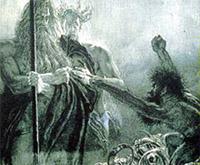The Norse Presence in LotR
| [ her ] |
| pictures |
| biography |
| dates |
| quotes |
| [ them ] |
| aragorn |
| faramir |
| éomer |
| merry & pippin |
| [ more ] |
| places |
| sisters |
| horses |
| music |
| myth |
| trivia |
| writings |
| links |
| fans |
| home |
This article is more generalized in nature. Éowyn can be compared to dozens of similar characters from mythology, history and literature. So if you're looking for specific parallels related to her, head on over to the sisters page.
Every Tolkien fan knows about the professor's supposed inspiration from Norse mythology in his creation of Middle-earth. So I've gone a step further and compiled a list of some of the parallels.
The great ring ANDVARINAUT, so named after its creator, the dwarf Andvari, caused much grief in the Norse pantheon. After the god Loki demanded this prize, the dwarf put a curse on it. Here, the dwarf Andvari protects his hoard as Loki (in the background), persuades Odin to help him take the ring.
The Norse Elements in LotR:
(Tolkien terms in bold)
The Ainur (Valar and Maiar), the "Holy Ones" - Comparable to these two orders of first beings in 'The Silmarillion' are the Norse gods themselves, who were divided into two factions--the older race of VANIR and the younger AESIR (of which Odin and his contemporaries were members).
The Ring of Power- There are numerous "rings of power" in Norse myth. The most famous was called DRAUPNIR, and was Odin's own ring. It was forged by the dwarf brothers Sindri and Brokk, and every ninth night the ring dripped gold to make eight copies of itself. Unlike Tolkien's One Ring, DRAUPNIR represented the fertility and power of the world.
Another more infamous ring was called ANDVARINAUT, forged by the dwarf Andvari as the prize of his own immense hoard of gold. When the wicked god Loki demanded the ring, Andvari put a curse on it to cause the doom of whoever wore it. And the curse worked--it caused the maiden Brynhild to kill herself when her lover Sigurd gave her the ring as a gift (she became convinced Sigurd had betrayed her). It also caused Fafnir to slay his own father Hreidmar in greed to protect his treasure. Fafnir later used the ring's power to turn himself into a dragon to guard this treasure (not unlike Smaug in 'The Hobbit').
Dwarves - There are many dwarves (or 'dwarfs') throughout Norse myth, and like Tolkien's creations, they were all great forgers and builders. ALVIS, for example, made the weapons of the gods, including Thor's great hammer. ANDVARI, like Celebrimbor, was a ring-forger. As were brothers SINDRI and BROKK, the underground hermit LAURIN, and ALBERICH, who forged a ring of power that caused a great war among the giants and lead to an ages-long search by desperate Odin and his contemporaries.
Bilbo and Gollum - There's a story in Norse myth about a hero named DIETRICH who won a ring from the dwarf LAURIN, who ruled a magnificent underground kingdom. After a test of wits, Dietrich won the ring, as well as a magic cape of invisibility.
Bilbo and the Trolls - Alvis, the dwarf who forged the weapons of the gods, was promised the hand in marriage of Thor's own daughter. Thor did not approve of this at all, so he tested Alvis' wisdom, questioning and arguing with the dwarf until dawn's first light, when Alvis turned to stone.
The Nazgûl - It might sound like a stretch, but Tolkien's black riders share many similarities with Odin's VALKYRIES. More modernly seen as more feminine symbols of courage, early Valkyries were bloodthirsty demons of death who ravaged battlefields astride bat-winged dragons, enslaved by their lust for Odin's ring Draupnir.
Aragorn & Arwen - The beautiful Norse goddess of fertility, FREYJA, had a human lover OTTAR, who was the leader of a nomadic band of mercenary warriors. Freyja was the possessor of the Brisings necklace, and wore it to ensure Ottar's devotion, as it enhanced her already divine beauty. When obligations of the mortal world threatened to pull Ottar away, Freyja sacrificed the necklace in order to obtain the magic to keep Ottar with her in the immortal world.
The Mearas - Odin had an eight-legged stallion named SLEIPNIR ("Glider"). He was the swiftest horse of all horses and could travel over sea and through the air.
Aragorn - Almost every religion in the world has a figure with a destiny similar to Aragorn's "triumphant return of the king." The Egyptians have OSIRIS, the Sumerians had TAMMUZ, and the Greeks had ADONIS. The Celts had KING ARTHUR, who's supposed with his Knights of the Roung Table when needed. And the Norse had BALDER, a poetic and beautiful god tricked into death who returned to rule. Even CHRIST fits into this description.
Middle-earth - Norse plane of MIDGARD, the home of humankind.
DRAUPNIR was perhaps the most famous of the enchanted rings of Norse mythology. It was Odin's ring, forged by the dwarf brothers SINDRI and BROKK. The ring was said to drip gold and, every ninth night, would spawn eight copies of itself. Unlike Sauron's ONE RING, though, DRAUPNIR was not an evil ring that brainwashed its wearer. Instead, the ring was a powerful fertility charm. Odin did use it, however, to control his Valkyries--not unlike Sauron's control over the Nazgûul.
This image, by illustrator Alan Lee, depicts Draupnir's forging within the same type of caverns Tolkien adopted as the habitat for his own dwarves.
Original article written August 2002, with additions.
Images © Alan Lee & F. Von Stassen.

